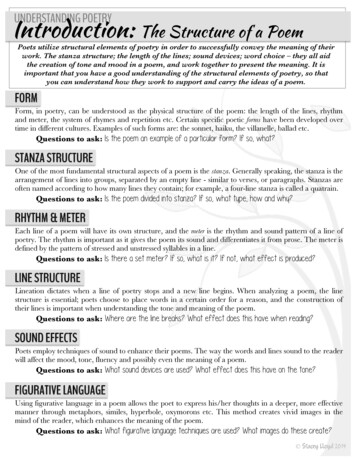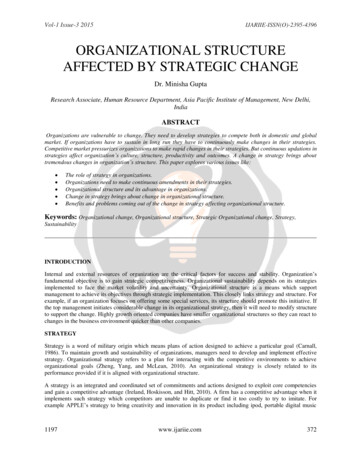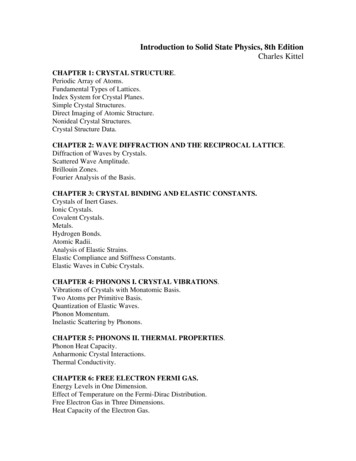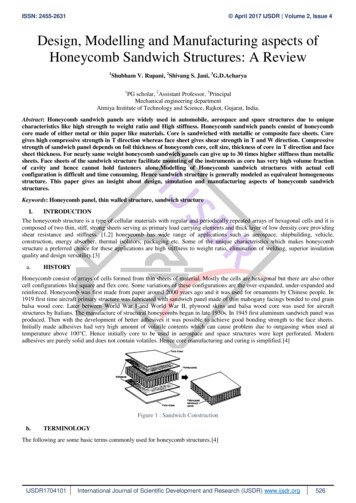
Transcription
UNDERSTANDING POETRYIntroduction: The Structure of a PoemPoets utilize structural elements of poetry in order to successfully convey the meaning of theirwork. The stanza structure; the length of the lines; sound devices; word choice – they all aidthe creation of tone and mood in a poem, and work together to present the meaning. It isimportant that you have a good understanding of the structural elements of poetry, so thatyou can understand how they work to support and carry the ideas of a poem.FORMForm, in poetry, can be understood as the physical structure of the poem: the length of the lines, rhythmand meter, the system of rhymes and repetition etc. Certain specific poetic forms have been developed overtime in different cultures. Examples of such forms are: the sonnet, haiku, the villanelle, ballad etc.Questions to ask: Is the poem an example of a particular form? If so, what?STANZA STRUCTUREOne of the most fundamental structural aspects of a poem is the stanza. Generally speaking, the stanza is thearrangement of lines into groups, separated by an empty line - similar to verses, or paragraphs. Stanzas areoften named according to how many lines they contain; for example, a four-line stanza is called a quatrain.Questions to ask: Is the poem divided into stanza? If so, what type, how and why?RHYTHM & METEREach line of a poem will have its own structure, and the meter is the rhythm and sound pattern of a line ofpoetry. The rhythm is important as it gives the poem its sound and differentiates it from prose. The meter isdefined by the pattern of stressed and unstressed syllables in a line.Questions to ask: Is there a set meter? If so, what is it? If not, what effect is produced?LINE STRUCTURELineation dictates when a line of poetry stops and a new line begins. When analyzing a poem, the linestructure is essential; poets choose to place words in a certain order for a reason, and the construction oftheir lines is important when understanding the tone and meaning of the poem.Questions to ask: Where are the line breaks? What effect does this have when reading?SOUND EFFECTSPoets employ techniques of sound to enhance their poems. The way the words and lines sound to the readerwill affect the mood, tone, fluency and possibly even the meaning of a poem.Questions to ask: What sound devices are used? What effect does this have on the tone?FIGURATIVE LANGUAGEUsing figurative language in a poem allows the poet to express his/her thoughts in a deeper, more effectivemanner through metaphors, similes, hyperbole, oxymorons etc. This method creates vivid images in themind of the reader, which enhances the meaning of the poem.Questions to ask: What figurative language techniques are used? What images do these create? Stacey Lloyd 2014
UNDERSTANDING POETRYStanza Structurestanza ˈstanzəә nouna group of lines forming the basic recurringmetrical unit in a poem; a verse.One of the most basic and fundamental structural elements of a poem is the stanza. Generally speaking, thestanza is the arrangement of lines into groups, separated by an empty line - similar to verses, or paragraphs.Types of stanzas:One way to understand stanza structure is to count thenumber of lines in a stanza. There are names forstanzas with different numbers of lines:2 lines: Couplet3 lines: Tercet4 lines: Quatrain5 lines: Cinquain6 lines: Sestet7 lines: Septet8 lines: OctaveNote:Some poems will stick to a rigid stanza structure witheach stanza consisting of the same number of lines,while other poems may be composed of a mix ofdifferent lengths of stanzas.Stanzas are also often characterised by a certainrhyme scheme. For example, a couplet typically istwo lines of the same length which rhyme.Is the stanza structure of a poem significant?How a poet choses to structure their words is important. Stanzas are often deliberately organised to serve apurpose. This may be in order to group ideas or images together, to indicate a change in tone, idea orfocus, or the stanza breaks can be used as a pause for thought or to create a brief silence, which holdsmeaning. Similarly, a poem may not be broken up into individual stanzas, because the poet doesn’t wantyou to pause while reading.Have a look at an example:Examine the stanza structure of the poem below:Do Not Go Gentle into That Good NightBy Dylan ThomasDo not go gentle into that good night,Old age should burn and rave at close of day;Rage, rage against the dying of the light.Though wise men at their end know dark is right,Because their words had forked no lightning theyDo not go gentle into that good night.Good men, the last wave by, crying how brightTheir frail deeds might have danced in a green bay,Rage, rage against the dying of the light.Wild men who caught and sang the sun in flight,And learn, too late, they grieved it on its way,Do not go gentle into that good night.Grave men, near death, who see with blinding sightBlind eyes could blaze like meteors and be gay,Rage, rage against the dying of the light.And you, my father, there on the sad height,Curse, bless, me now with your fierce tears, I pray.Do not go gentle into that good night.Rage, rage against the dying of the light. Stacey Lloyd 2014
UNDERSTANDING POETRYStanza StructurePracticeWorksheetFor each of the following, briefly describe the stanza structure, and comment on how it affects the tone and meaning ofthe poem (you should do this in the same way as the example was analyzed on the information page).Suicide in the TrenchesBy Siegfried SassoonI knew a simple soldier boyWho grinned at life in empty joy,Slept soundly through the lonesome dark,And whistled early with the lark.In winter trenches, cowed and glum,With crumps and lice and lack of rum,He put a bullet through his brain.No one spoke of him again.You smug-faced crowds with kindling eyeWho cheer when soldier lads march by,Sneak home and pray you'll never knowThe hell where youth and laughter go.Acquainted with the NightBy Robert FrostI have been one acquainted with the night.I have walked out in rain — and back in rain.I have outwalked the furthest city light.I have looked down the saddest city lane.I have passed by the watchman on his beatAnd dropped my eyes, unwilling to explain.I have stood still and stopped the sound of feetWhen far away an interrupted cryCame over houses from another street,But not to call me back or say good-bye;And further still at an unearthly height,One luminary clock against the skyProclaimed the time was neither wrong nor right.I have been one acquainted with the night.Anthem for Doomed YouthBy Wilfred OwenWhat passing-bells for these who die as cattle?Only the monstrous anger of the guns.Only the stuttering rifles' rapid rattleCan patter out their hasty orisons.No mockeries now for them, no prayers nor bells;Nor any voice of mourning save the choirs, –The shrill demented choirs of wailing shells;And bugles calling for them from sad shires.What candles may be held to speed them all?Not in the hands of boys but in their eyesShall shine the holy glimmers of goodbyes.The pallor of girls' brows shall be their pall;Their flowers the tenderness of patient minds,And each slow dusk a drawing-down of blinds. Stacey Lloyd 2014
UNDERSTANDING POETRYPoems: Line Structureline lʌɪn nouna part of a poem or song forming one row ofwritten or printed words.Lineation dictates when a line of poetry stops and a new line begins. When analyzing a poem, the line structure isessential;poets choose to place words in a certain order for a reason, and the construction of their lines is important whenunderstanding the tone and meaning of the poem.You want to ask the following questions when thinking about the line structure of a poem.How long are the lines?The length of a line will affect the speed you read it, and will affect the tone and meaning. If the poem iscomposed of short lines, then you will read the poem quite quickly, as your eye moves rapidly from line toline. If the poet puts a single word on its own line, the word may be emphasized. What if the poem iscomposed of longer lines and then one line is considerably shorter? That will emphasize that particular line.Where does the line break or pause?Lines of poetry are not the same as sentences. One sentence, or thought can run over many lines and even end mid-line, and a newsentence can begin in the same line. Therefore, where the poet chooses to break the lines and start a new one is significant.Ø End-Stopped: When there is a break at the end of a line, denoted by a comma, period, semicolon, orother punctuation mark, that line is end-stopped, and the effect of this is that a brief pause is createdbetween lines. See the following example:Each line ends with a pause. This slows your reading ofthis final stanza and makes each line more deliberate, whichconveys the labored and tired feeling of the speaker.-Ø Enjambment: Enjambment is the continuation of a sentence or clause over a line-break; the thoughtruns on from one line to the next. See the following example:- From The Waste Land, by T.S EliotNote how these lines flow from one to the next without a break atthe end. This mimics the ongoing process of the seasons. It alsocreates tension as the reader gets to the last word and wonderswhat follows. Breeding what? Mixing . What? Stirring what?Ø Caesura: A strong pause or stop within a line is called a caesura. A caesura will usually occur in themiddle of a line of poetry, but can occur towards the beginning or the end of a line (but not betweenlines). These types of caesurae are called medial, initial, and terminal respectively. The effect of such apause is that it creates a brief silence for thought or reflection, and can emphasize certain words. See thefollowing example of a medial caesura:- From An Essay on Criticism, by Alexander PopeNote the break between “Humane” and “to”, created bythe semi-colon. This break emphasizes the comparisonand contrast between the human and the divine.What is the last / first word of the line?When a reader gets to the end of a line of poetry, the last word of the line is emphasized as it takes a splitsecond longer for the reader’s eye to move from the end of a line to the beginning of the next. Therefore,that last word stays in the mind of the reader just a fraction of a second longer. Often poets end their lineswith rhymes, which adds to the emphasis of these words. Stacey Lloyd 2014
PracticeWorksheetUNDERSTANDING POETRYLine StructureExamine thepoem below (which is written in free verse form) and then answer the questions about line structure.GranadillaBy Amy LowellI cut myself upon the thought of youAnd yet I come back to it again and again,A kind of fury makes me want to draw you outFrom the dimness of the presentAnd set you sharply above me in a wheel of roses.Then, going obviously to inhale their fragrance,I touch the blade of you and cling upon it,And only when the blood runs out across my fingersAm I at all satisfied.1. How is punctuation used in the poem? Explain 2examples, and discuss the effect produced.2. Explain how the length of the lines affects the poem’s tone or meaning.3. Are there any end-stopped lines? Give examples and explain the effect produced.4. Is there enjambment in the poem? Give an example and explain the effect produced.5. Are there any caesuras? Give an example and explain the effect produced. Stacey Lloyd 2014
PracticeWorksheetUNDERSTANDING POETRYLine StructureExamine thepoem below (which is written in free verse form) and then answer the questions about line structure.GrassBy Carl SandbergPile the bodies high at Austerlitz and Waterloo.Shovel them under and let me work—I am the grass; I cover all.1. How is punctuation used in the poem?Explain 2 examples, and discuss the effectproduced.And pile them high at GettysburgAnd pile them high at Ypres and Verdun.Shovel them under and let me work.Two years, ten years, and passengers ask the conductor:What place is this?Where are we now?I am the grass.Let me work.2. Explain how the length of the lines affects the poem’s tone or meaning.3. Are there any end-stopped lines? Give examples and explain the effect produced.4. Is there enjambment in the poem? Give an example and explain the effect produced.5. Are there any caesuras? Give an example and explain the effect produced. Stacey Lloyd 2014
meaning. Similarly, a poem may not be broken up into individual stanzas, because the poet doesn’t want you to pause while reading. Have a look at an example: Examine the stanza structure of the poem below: Do Not Go Gentle into That Good Night By Dylan Thomas Do not go gentle into that











